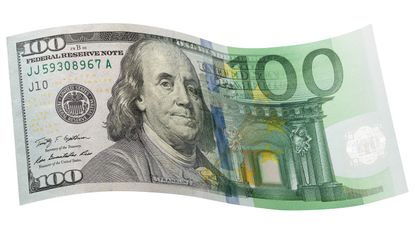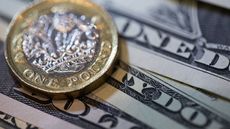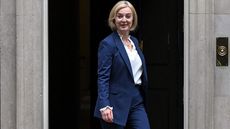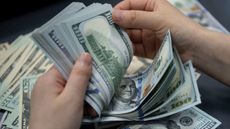The US dollar is ripe for sharp depreciation
The US dollar – usually considered a traditional “safe haven” refuge – suffered its worst monthly performance in nearly a decade last month as risk-averse investors shunned it.

Has the greenback reached a turning point? The US dollar index gained more than 10% between March 2018 and April 2020. The index measures the greenback’s value against a basket of six major trading partners’ currencies. Yet that trend has now gone into reverse, with the dollar falling by 4.4% in July, its worst monthly performance in nearly a decade. It is down by 9% from a mid-March high and has reached a two-year low.
Debasement, debt and dodgy institutions
The dollar’s reversal will have broad implications, says Amrith Ramkumar in The Wall Street Journal. The strong dollar was driven by US interest rates, which were higher than those on offer in Europe or Japan. That encouraged yield-hungry investors to park cash in dollar assets. Yet the US Federal Reserve has now slashed rates to near-zero and quantitative easing has expanded its balance sheet by almost $3trn in five months.
The dollar is still not particularly weak on a historical basis, notes Neil Shearing of Capital Economics, remaining above its ten-year average valuation in trade-weighted terms. Yet something mysterious is afoot. Risk-averse investors have been crowding into safe havens such as bonds and gold, but the dollar, another traditional refuge, has been shunned.
Subscribe to MoneyWeek
Subscribe to MoneyWeek today and get your first six magazine issues absolutely FREE

Sign up to Money Morning
Don't miss the latest investment and personal finances news, market analysis, plus money-saving tips with our free twice-daily newsletter
Don't miss the latest investment and personal finances news, market analysis, plus money-saving tips with our free twice-daily newsletter
What’s more, US inflation expectations have risen recently even as stocks remain stuck. The explanation may be that markets are positioning for a “regime shift” in US monetary policy, with a Federal Reserve that “tolerates – or indeed targets – higher inflation”. That makes the greenback a less attractive asset than it once was.
The dollar’s turnaround raises questions that “go to the heart of the global financial system”, say Colby Smith, Eva Szalay and Katie Martin in the Financial Times. Some 88% of deals in the $6.6trn foreign exchange market involve the greenback. Investors are now questioning whether US institutions can withstand a period of intense political polarisation. Donald Trump’s recent suggestion that the election should be delayed has hardly allayed fears of civil strife.
A boon for stocks
American political dysfunction compares unfavourably with Europe, which is taking unprecedented steps towards fiscal union, says Stephen Roach in Project Syndicate. A rising euro has been a significant factor driving the dollar’s recent fall. The macroeconomic picture is also unfavourable for the greenback, with the US running a current account deficit while the eurozone runs a surplus. All this suggests that an “overvalued US dollar is ripe for a sharp devaluation”.
Many will cheer a weaker dollar, says Reshma Kapadia in Barron’s. It could spark a boom in emerging markets by providing cheaper financing costs for local businesses. A falling currency also bodes very well for American stocks because a weaker currency flatters the overseas earnings of US companies when translated into dollar terms. David Kostin of Goldman Sachs notes that a 10% fall in the trade-weighted index boosts S&P 500 earnings per share by 3%.
-
 Barclays warns of significant rise in social media investment scams
Barclays warns of significant rise in social media investment scamsInvestment scam victims are losing an average £14k, with 61% of those falling for one over social media. Here's how to spot one and keep your money safe
By Oojal Dhanjal Published
-
 Over a thousand savings accounts now offer inflation-busting rates – how long will they stick around?
Over a thousand savings accounts now offer inflation-busting rates – how long will they stick around?The rate of UK inflation slowed again in March, boosting the opportunity for savers to earn real returns on cash in the bank. But you will need to act fast to secure the best deals.
By Katie Williams Published
-
 Why you should keep an eye on the US dollar, the most important price in the world
Why you should keep an eye on the US dollar, the most important price in the worldAdvice The US dollar is the most important asset in the world, dictating the prices of vital commodities. Where it goes next will determine the outlook for the global economy says Dominic Frisby.
By Dominic Frisby Published
-
 Sterling accelerates its recovery after chancellor’s U-turn on taxes
Sterling accelerates its recovery after chancellor’s U-turn on taxesNews The pound has recovered after Kwasi Kwarteng U-turned on abolishing the top rate of income tax. Saloni Sardana explains what's going on..
By Saloni Sardana Published
-
 Will Liz Truss as PM mark a turning point for the pound?
Will Liz Truss as PM mark a turning point for the pound?Analysis The pound is at its lowest since 1985. But a new government often markets a turning point, says Dominic Frisby. Here, he looks at where sterling might go from here.
By Dominic Frisby Published
-
 Are we heading for a sterling crisis?
Are we heading for a sterling crisis?News The pound sliding against the dollar and the euro is symbolic of the UK's economic weakness and a sign that overseas investors losing confidence in the country.
By Alex Rankine Published
-
 The US dollar is rising to dangerous levels – here’s what to do about it
The US dollar is rising to dangerous levels – here’s what to do about itAnalysis The US dollar is back on the rise as panicky investors head for safety. That’s rattling markets across the world, says Dominic Frisby. Here’s how to cope.
By Dominic Frisby Published
-
 Investors dash into the US dollar
Investors dash into the US dollarNews The value of the US dollar has soared as investors pile in. The euro has hit parity, while the Japanese yen and the Swedish krona have fared even worse.
By Alex Rankine Published
-
 Why a strong dollar hurts – and what you can do about it
Why a strong dollar hurts – and what you can do about itAnalysis The US dollar is at its strongest level in 20 years. That’s bad news for most investment assets, says John Stepek – here’s why
By John Stepek Published
-
 Can anything stop the dollar’s devastating bull run?
Can anything stop the dollar’s devastating bull run?Analysis The US dollar has been on a massive bull run for the last year or so. Commodity prices are sliding, and the euro – maybe even the pound – could hit parity. But when it turns there will be mad scramble, says Dominic Frisby. Here, he looks at what might halt the runaway dollar.
By Dominic Frisby Published